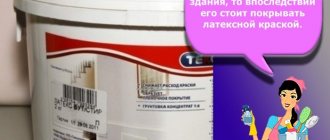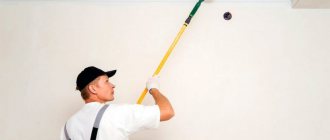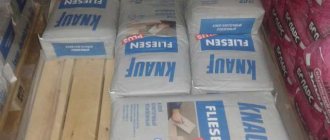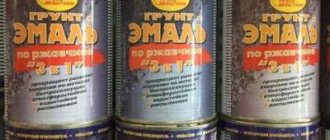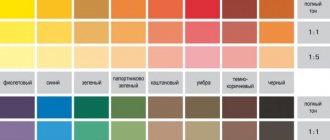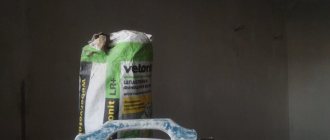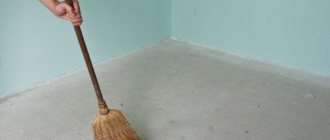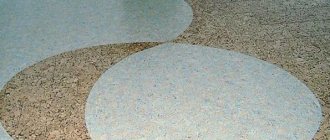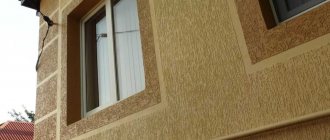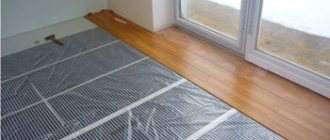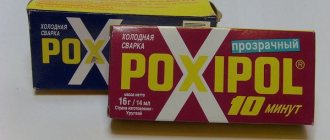Any surface must be primed before applying finishing paints and varnishes. This method of painting ensures the durability of the paint. Alkyd primer has a high degree of resistance to aggressive environments. This primer is used to cover surfaces that need protection from moisture. After complete drying, the protective primer layer is coated with alkyd paints. It is not recommended to use paints that are not compatible with the primer for this purpose.
Carrying out work on applying alkyd primer
Modern alkyd primers are produced by manufacturers ready for use, that is, no work on diluting the solution, concentrate, or dry material is required.
Before working with alkyd primer, it is recommended to wear special clothing: gloves, a respirator and goggles. This category of primers is toxic, so safety and precautions should be observed
Step-by-step work on priming surfaces with alkyd primer will look like this:
- You should start with preliminary preparation of the surface for priming. If the base is metal, its surface layer is thoroughly cleaned of rust. Wooden surfaces are sanded with sandpaper to remove burrs and irregularities. If there are deep cracks in the wooden base, they must be filled with putty.
- The prepared surface is degreased with a special compound and dried.
- Before use, the primer mixture must be stirred. Some high concentration solutions may require dilution with a solvent to a certain viscosity level. You can find information about whether it is necessary to dilute the soil before work in the instructions for use of the material from the manufacturer.
The primer is applied to the surface with a brush, roller, or sprayer.
It is important to ensure that the soil lies evenly, without forming streaks or accumulations on certain areas of the surface.. https://www.youtube.com/embed/lHbZ0CNTQVE
After the applied layer has dried, the alkyd primer is applied as a second layer. The exact drying time depends on the type of soil, and you can clarify it by studying the instructions for using the material.
The right combinations of materials
The difference between acrylic and alkyd enamels and general recommendations for use, the correct combinations of materials.
Properties of one-component acrylic enamels
Unlike acrylic emulsions in jars, aerosol acrylic enamels have an organic rather than aqueous base.
Advantages (compared to alkyd aerosol enamels):
- high drying speed;
- rich colors;
- high elasticity and high adhesion to plastics (due to these properties, acrylic enamels are preferable for application to plastic surfaces).
Disadvantages (compared to alkyd aerosol enamels):
- moderate weather resistance;
- moderate adhesion to metals (preliminary priming is required);
- moderate resistance to solvents.
Properties of one-component alkyd enamels
The peculiarity of alkyd enamels compared to acrylic enamels is that after drying the chemical processes in them do not end. After the solvent has evaporated, the polymerization process continues in the alkyd enamel under the influence of atmospheric oxygen. The molecules are “stitched” together and, figuratively speaking, form one large molecule, making the coating more durable and resistant to various influences, but at the same time less elastic and more fragile. However, alkyds have been discovered for a very long time and are very well studied. Modern KUDO ® formulations take this fact into account, and even after complete polymerization, the paint film remains quite elastic. The polymerization process can last from several days to two weeks. During polymerization, the coating must not be subjected to mechanical stress. For example, a car body element painted with alkyd enamel cannot be washed or polished for two weeks. Also, during polymerization, alkyd enamel cannot be coated on top with other paints and varnishes, even those based on alkyd - the coating may be damaged. You need to coat either “wet on wet”, that is, apply the next coating immediately after drying “touch to touch”, or after waiting for complete polymerization. When applied “wet on wet”, the adhesion of the applied layer will be higher than when applied after complete polymerization. Aerosol alkyd paints are highly weather resistant and do not require additional varnish.
Advantages (compared to acrylic aerosol enamels):
- high adhesion to metals;
- higher hardness;
- higher weather resistance;
- higher light fastness (less fading);
- higher resistance to solvents.
Disadvantages (compared to acrylic aerosol enamels):
- longer drying time;
- long polymerization process.
Important!
Recommendations for the selection of materials necessary for repairing the paintwork of a car can be found on the pages 1K automotive metallic enamel and 1K automotive alkyd enamel.
Table of correct combinations
The alkyd base cannot be coated with paints and varnishes during its polymerization - the alkyd base may swell! The alkyd coating must be applied to the alkyd base either “wet on wet” **, that is, immediately after the base has dried “touch” (no later than 1.5 hours after applying the base), or after waiting for complete polymerization. * Does not apply to application on the ground!
When applied “wet on wet”, the adhesion of the applied layer will be higher than when applied after complete polymerization.
Alkyd coating can be applied to an acrylic base ** by waiting until the base is touch dry. *
You can also apply the coating after the base has completely dried.
Attention!
Do not apply aclide-urethane coatings, in particular yacht varnish, to one-component acrylic primer - the base may swell.
The alkyd base cannot be coated with paints and varnishes during its polymerization—the alkyd base may swell. An acrylic coating on an alkyd base must be applied either “wet on wet”, that is, immediately after the base has dried “touch” (no later than 1.5 hours after applying the base), or after waiting for complete polymerization. *
When applied “wet on wet”, the adhesion of the applied layer will be higher than when applied after complete polymerization.
Acrylic coating can be applied to an acrylic base by waiting until the base is touch dry. *
You can also apply the coating after the base has completely dried.
* Intermediate drying time between layers, touch-drying time, complete drying time and the time for the base to gain full mechanical strength are indicated in the instructions for use of each specific product. Alkyd enamels do not require additional varnishing.
** We recommend using a primer color as close as possible to the enamel color.
If the acrylic base is brightly colored, then when a thick layer of alkyd coating is applied to it (especially light colors), the bright pigment of the base may “rise.” The same is possible when applying an alkyd coating to an alkyd base “wet on wet”. For example, if a brown-red acrylic primer is painted with white alkyd enamel, then there is a high chance of getting a pink finish.
How to apply acrylic coating to acrylic base.
Acrylic coating can be applied to an acrylic base by waiting until the base is touch dry.
You can also apply the coating after the base has completely dried.
How to apply alkyd coating to acrylic base.
Alkyd coating can be applied to an acrylic base by waiting until the base is touch dry.
You can also apply the coating after the base has completely dried.
Attention!
Do not apply aclide-urethane coatings, in particular yacht varnish, to one-component acrylic primer - the base may swell.
How to apply acrylic coating to an alkyd base.
The alkyd base cannot be coated with paints and varnishes during its polymerization—the alkyd base may swell. An acrylic coating on an alkyd base must be applied either “wet on wet”, that is, immediately after the base has dried “touch” (no later than 1.5 hours after applying the base), or after waiting for complete polymerization, when the coating has gained full strength.
When applied “wet on wet”, the adhesion of the applied layer will be higher than when applied after complete polymerization.
Kinds
When considering this type of primer, it is necessary to highlight several of its main varieties, differing in composition and properties.
- Glyphthalic. Suitable for all types of finishing work, both external and internal. Used to create a protective film on wood, metal, glass and concrete. Be sure to apply paint or varnish over the primer to create a more powerful protective layer. There are separate varieties used only for metals and their alloys; they have additional additives to prevent corrosion.
- Perchlorovinyl primer is used only for external work on plaster or concrete. Dries within 60-90 minutes.
- Polyvinyl acetate primer. Dries in 35-40 minutes, used only in combination with paints.
- Composition with polystyrene. It is very toxic, so it cannot be used for interior finishing work. For use on wooden bases only.
- Alkyd-urethane composition. Designed for metal processing only. Often used when working with vehicles or metal structures that experience various types of environmental influences: precipitation, temperature changes.
- Phosphating. Increases adhesion. For use with metal only.
- Inhibitory. Forms a layer of water- and oil-repellent surface.
- Passivating. Slows down the corrosion process. Forms a thin waterproof layer on the surface.
- Protective. Designed for working with rust. Forms a base that prevents the appearance of new scratches and rust. One of the most popular manufacturers of such a primer is.
Safety precautions
According to labor safety standards, when working with primer compositions, it is necessary to prevent the working compositions from getting on the skin, eyes, mucous membranes, or inside the body.
Personal protective equipment is used during primer treatment.
If the working mixture accidentally gets on the skin, quickly wipe it with a clean rag and wash with running water and soap. In case of contact with mucous membranes, consult a doctor immediately.
It must be remembered that fire safety standards must be observed at the facility . When mixing primers, the presence of open flames and ignition sources is unacceptable. The tool used should not produce a spark when struck.
Workers must undergo preliminary training, training in safe work skills, and a medical examination. Concrete work is carried out using scaffolding (scaffolding, scaffolding). The processing area is fenced.
Benefits of primer
It is believed that before carrying out paintwork it is necessary to apply a primer layer. This is due to the fact that treatment with an impregnating composition has a positive effect on the quality of wood and extends its service life. The benefits of the primer:
- disinfection, protection from mold and rot, the substances included in the solution reliably protect the wood from destruction and extend its service life;
- the primer penetrates deep into the wood and clogs its pores;
- after treatment, a thin film appears on the surface, which repels water and protects against dampness and moisture;
- the consumption of paint or varnish is reduced, because after priming the absorbency of the base decreases;
- some antiseptic compositions provide protection against insects and rodents and contain repellent substances;
- after priming, the surface becomes rough, which improves adhesion;
- Wood contains a coloring pigment - tannin, which can come to the surface after staining, which can cause dark spots to appear on the surface. The primer seals the pores, preventing tannin from escaping and preventing the appearance of dark spots;
- the impregnating composition contains special resins that “glue” wood fibers together, making the material more durable, so priming is necessary for old surfaces;
- masks the old coating, makes the color of the base less noticeable; tinted primers are also available, which contribute to deeper coloring of the material.
Carrying out work on applying alkyd primer
The primer is applied using different tools:
- roller;
- brush;
- air or airless spray.
Usually the most accessible and safest method is chosen. For example, it is extremely difficult to use air spraying when priming indoor surfaces, since a mist of fine sprays of material rises, making it impossible to breathe and requiring the use of insulating gas masks.
Airless spraying is safer. This option is used to prepare embossed surfaces that are full of small details or irregularities. Typically, these areas are difficult to cover with a brush or roller, but a sprayer can help get the job done in a short period of time.
Brush or roller application provides the most economical and cleanest finishing option. As a rule, a roller is used on large flat surfaces, and brushes are used to finish corners, joints, transitions and other areas that are inaccessible to a roller.
The primer application process consists of several stages:
- Preparation. The treated surface is freed from foreign objects, lanterns, hanging furniture or equipment. The old sheathing or finishing layer is removed. The crumbling or flaking areas are completely removed, leaving only dense and durable areas. Metal surfaces are cleaned of deposits and rust;
- the surface is degreased with a special compound. The primer is mixed and diluted with white spirit to obtain a working viscosity;
- apply a layer of primer. If this is a primer (deep penetration composition), you can spare no expense and apply the material in a thick layer, ensuring saturation of the array to a greater depth. Other types of primer should be applied in a thin layer, otherwise it will not be able to dry properly and will take a lot of time;
- After the first layer has dried, apply the second. The interlayer drying time is indicated on the material packaging. Between layers, it is recommended to perform additional grinding of the surface, since irregularities and burrs that were not previously visible will become noticeable;
- dry the material. Further work can be carried out only after the primer layer has completely dried.
Attention! When applying a primer by spraying, the material must be thinned more, which makes it more liquid and reduces the dry residue. Therefore, more layers have to be applied, which takes time and increases material consumption.
How to prime concrete
Several types of primer materials work successfully on concrete. The choice of the optimal solution is based on the principles of subsequent processing, the materials used in the intermediate and finishing layers. The type of operation of the structure and its actual condition are taken into account.
Primers carry a complex of functions:
- strengthening is important on plastered concrete, where there are areas with an unstable, loose structure. The soil works to clog pores and compact, in which deep penetration compositions are especially successful;
- corrosion protection – in demand when working on reinforced concrete surfaces. The anti-corrosion effect will provide protection for fittings, metal embedded parts, etc.;
- increased adhesion – primer mixtures with increased adhesion are in demand on concrete that is affected by organic or inorganic contaminants.
Based on the type of binder, primers are divided into acrylic, polyurethane, latex, etc.
In most cases, universal primers are used for interior work. Such primers work on any brand and any density of concrete. The penetration depth varies between 5-9 mm , which provides high adhesive capabilities.
Subtleties of use
All alkyd primers are now sold ready-to-use, so there should be no difficulties in working with them. By following these step-by-step instructions, you can correctly apply primer to any surface.
- The first step is to prepare the material for application of the primer. If it is metal, then there should be no rust or traces of corrosion on it. All burrs are removed from the tree, and the cracks are covered and puttied.
- Next, you need to degrease the surface.
- The soil mixture is stirred. The manufacturer must indicate on the packaging exactly the consistency at which the primer will have the best adhesive properties.
- The primer is applied with a roller or brush. For some species you can use a spray bottle.
- During the application of the material, it is necessary to ensure that the layer is as even as possible.
- Most often, after drying, you will need to apply a second coat.
The consumption of material when spraying is minimal - about 130 grams per 1 sq. m in two layers. When using a roller or brush, the consumption increases to 200 grams per 1 square meter. m. Work on applying the primer must be carried out at temperatures from -10 to +25 degrees using personal protective equipment.
The use of an alkyd primer is necessary when working on metal or wood surfaces. Improving surface characteristics is something every builder should strive for, and the use of appropriate compounds will help achieve this goal.
See below for tips on applying primer.
Tools and equipment
Proper application of primers requires the use of special equipment and professional tools.
If the concrete base requires preliminary preparation, use the following:
- grinding machines - used in the preparation of floors against the backdrop of a large volume of work. It is recommended to use high-performance, durable machines with a power of at least 3.1 kW. In hard-to-reach areas they work with hand-held grinders, power from 700 W;
- sandblasting, shot blasting machines - high-performance equipment will be required to clean the bases. The optimal volume of the bunker is 25 l;
- industrial vacuum cleaners, hard metal brushes - used to clean and remove dust from the surface.
To apply primers you will need the following:
- construction mixer – used for preparing two-component soils and stirring one-component ones. It is optimal to work with a tool with a power of 1.4 kW, at a speed of 450-700 rpm. The device must work in forward and reverse directions;
- clean container;
- thin brushes, paint brushes - primers are applied with professional brushes with synthetic bristles, which do not leave lint on the finished layer. Mockrowers work well on uneven substrates where filling uneven spots and voids is required. Thin brushes are useful for working in hard-to-reach areas;
- rollers – primers are conveniently applied with wear-resistant rollers made on the basis of polyamide. Short-haired or medium-haired coats are used;
- spray guns - depending on the type of primer, air or airless spraying devices are used.
In addition to the specified equipment, personal protective equipment will be required: respirators, goggles, gloves, overalls, safety shoes.
Characteristics and Features
The main features of soils based on alkyd components include the following:
- Excellent resistance to temperature conditions;
- Reducing the consumption of materials used for surface finishing;
- Increasing resistance to abrasion, wear and chemical elements;
- Absolute surface protection from fungus, mold, rust and swelling;
- Eliminates the risk of resin protruding from the wood surface.
It should be noted that soil characteristics are often based on composition. That is why the following types of alkyd mixtures should be distinguished, taking into account the types of composition:
- Glypthal soils. They differ from other representatives in that the mixture includes a dye and a special filler, with which you can increase the efficiency of external and internal work;
- Perchlorovinyl mixtures - used in working with concrete, metal and plaster. They have a high degree of drying, but are mixtures with a high level of toxicity. That is why they are used in outdoor work using safety measures;
- Polyvinyl acetate mixtures are used before exterior finishing based on alkyd components. They have the most favorable drying time - 30 minutes;
- Alkyd-acrylic compositions are characterized by deep penetration into the material. This type of primer is considered a universal processing tool and is successfully used in working with wood and metal.
Despite the great difference in the characteristics of the components that may be included in alkyd primers, the surface treatment product always has excellent characteristics. The main thing is to follow the instructions and take advantage of safety measures.
Main properties and scope
Alkyd primer composition is almost universal. It is used to improve the quality of surfaces of wood, metal, glass, galvanized steel, and concrete.
Alkyd primer applied to external metal structures and technical parts of buildings and industrial structures will reliably protect them from corrosion. Later, the primed metal surface is painted with alkyd paint (enamel). This combination of coatings gives the metal anti-corrosion resistance.
Primed metal will use much less paint. The polymers that make up the soil fill all the small cracks and pores on the metal surface. Thus, additional mechanical protection of the surface is created.
Alkyd primer can be used on wooden surfaces before applying decorative and finishing materials (paint, putty, glue). If the surface of a tree is primed, then to create an external protective layer, in addition to alkyd paints, you can use liquid wallpaper. This combination of finishing materials with the base gives an excellent result, providing the wood with durability.
Thanks to the high adhesion ability of soil and liquid wallpaper, a coating is created that is inseparable from the wooden surface. Wood can also be painted using one or two layers of alkyd impregnation.
Concrete, just like metal and wood, after applying protective primers, should be painted with alkyd paints.
Completely dried alkyd primer creates, thanks to the polymers contained in its composition, a protective film. Therefore, primers, alkyd paints and impregnations are suitable for use in exterior work and interior decoration.
Alkyd primer is compatible with alkyd impregnation, alkyd and acrylic paints, nitro paint, PVA glue and acrylic putty. It is not recommended to use this type of soil for finishing work on gypsum, plaster and any other crumbling building materials. This does not apply only to concrete.
Prices for alkyd primer
Prices for alkyd primer depend on the type of material, manufacturer, technical characteristics, packaging volume and pricing policy of the retail outlet. However, it is worth noting that in terms of price, alkyd primers are the most affordable for consumers. Alkyd primers of the following brands are in particular demand among buyers: TIKKURILA, Ceresit, Lakra, Technoline. The average cost of one kilogram of material ranges from 60 to 700 rubles.
Alkyd primers are a universal material that has excellent technical characteristics, can be used for interior and exterior work, and has an affordable price for the consumer. The use of alkyd primers in repairs will allow you to obtain a beautiful finishing coating, which will also be reliably protected from the effects of negative environmental factors
However, you should remember: alkyd primers are toxic and therefore precautions should be taken when working with them.
conclusions
Priming concrete bases is an important technological operation on which the durability, strength of the finishing layers and the base itself depend. All work must be carried out with the highest quality and competence. The cost of professional processing of simple bases starts from 300 rubles per square meter . The choice of an effective material should be based on the actual condition and operating characteristics of the structure.
A detailed description of the properties and application of primer for interior concrete work is shown in the video:
Types of alkyd primers
There are several types of alkyd primers, which differ in their properties and areas of use.
The most popular and widespread primer coatings are:
The primer dries as quickly as possible - literally in one hour (at a temperature of 19-21 degrees Celsius). This primer is highly resistant to chemicals. The cost of perchlorovinyl primer is higher than that of glittalium.
On sale you can find all these types of alkyd primers from various manufacturers. However, soil is considered one of the most popular today. On the Internet you can find a large number of positive customer reviews about the products of this company.
To summarize, we can conclude that alkyd primer is a whole range of primer materials, the properties of which vary slightly. They are designed for processing wood, metal and other types of surfaces. All types of alkyd primers increase the strength of the treated surfaces, their adhesion, and also have antiseptic and many other properties.
To learn how to choose a primer, watch the following video.
WHICH WALL PRIMER IS BEST SUITABLE
Finishing of internal and facade walls with alkyd primers differs in operating conditions and safety requirements. First of all, it should be understood that alkyd primers are not enamels; they have a similar composition, but a completely different structure on the wall surface. If we draw an analogy, glypthal enamel can be compared to a high-quality aluminum pan, while alkyd primer, at best, looks like a colander.
Some of the most commonly used ones include:
- GF 021, GF 032 - general purpose primer for preparing wooden and metal surfaces and walls for painting. Option GFP 021 contains substances that convert rust residues into a stable insoluble compound with a dense structure. Good primer for wood;
- Soil GF 0119 GOST 23343-78. The composition for treating wooden, metal, concrete walls of internal non-residential premises is diluted with xylene, solvent, and white spirit. Touch-drying time is 90-120 minutes, complete drying at room temperature is 10 hours. The dried surface is absolutely safe, but application requires the use of good supply and exhaust ventilation. Typically comes in red-brown color;
- Alkyd primer "Tikkurila" with the effect of anti-corrosion protection of ferrous metals. Available in five colors: green, gray, red-brown, black, silver. Apply to completely dry surfaces. Drying time – 5 hours. Used to coat metal and concrete walls.
Important! For interior work, it is recommended to use alkyd primer No. 021 and No. 0119. All primers containing rust modifiers or for which toluene-based solvents are used are strictly not recommended for treating interior walls.
Often, glypthal varnishes can be used as an alkyd primer for gluing wallpaper on walls to strengthen the wooden surface. They do not contain red lead or lead pigments, so they will always be safer and easier to use.
What is a primer?
Alkyd primers represent a number of the most popular types of primer mixtures that are used in the repair of objects for any purpose. The demand for the compositions is very stable and high, which is achieved due to the positive characteristics and versatility of the mixture.
The primer can be used to treat various surfaces, from metal to plastic, wood and even glass.
The primer mixture provides excellent surface protection and also creates the basis for optimal coverage with facing materials. Despite the popularity of the composition, the product has both positive characteristics and negative features, which will be discussed further.
See also: all types of primers for metal
Advantages
The positive features of alkyd primers are as follows:
- The highest soil strength;
- Absolutely resistant to abrasion after the mixture has dried;
- Excellent hiding of resinous knots. They do not disturb the eyes even several years after treatment;
- Paints of any type (enamel, acrylic, etc.) as well as various types of glue (universal, wallpaper and PVA) fit perfectly onto the primer. Putty can also be applied to the surface;
- Many packages and cans indicate metal. However, the mixture is excellent for treating any other surfaces (plastic, wood, laminate, plaster, etc.);
- The ability to use the composition even at subzero temperatures, using basic methods to ensure the effectiveness of the mixture;
- Worker-friendly composition that has a minimal amount of toxins. Despite recommendations regarding the use of special safety equipment (masks, gloves, etc.), performing work without them will not pose any harm to health. Also, the time to ventilate the room after work is significantly reduced in comparison with soils based on other components.
Thanks to these advantages, the mixture has gained a foothold in the modern market for a long time, and is also popular in many areas of construction activity.
Flaws
Despite the impressive list of advantages, primer based on alkyd components has the following negative features:
Drying takes a long time, so it is important to create optimal conditions with good ventilation; Upon contact with the mixture, some paints may curl, because some soil characteristics are activated only after drying; Only the top ball of the surface can be processed
The product does not penetrate into the depth of the material, therefore it cannot be used for fastening loose surfaces. In such cases, acrylic-based primers should be used; The mixture cannot be used for processing synthetic materials, because they may bubble and stretch significantly; Despite the minimal list of toxic substances in the primer, the mixture has a specific odor, so it is better to thoroughly ventilate the room; Tools used to work with alkyd primer are difficult to wash with plain water. It is necessary to use white alcohol, and also try to isolate brushes and rollers from air to avoid drying out.
Despite these disadvantages, alkyd primers are rightfully considered a popular means for primary surface treatment. If you use the mixture correctly, its characteristics and features will speed up work and improve the quality of surfaces.
Where is it used?
Alkyd primers can be used in repair and finishing work to treat various types of surfaces to ensure resistance to moisture and other biological and chemical influences.
Using the mixture will protect the surface from the formation of rust and fungus.
Also, treatment with alkyd compounds makes it possible to significantly strengthen the surface of an object and fill its pores and crevices, which will allow the use of less materials for finishing.
Alkyd primer mixtures are used in the following types of work:
- For processing wood, OSB and chipboard before finishing painting;
- For covering walls before applying wallpaper or putty;
- For processing metal before applying finishing paint.
The use of primer ensures a high level of adhesion between all balls of the finished surface
The external coating will have impressive resistance to mechanical, chemical and biological influences, which is important when treating surfaces that are located outdoors
Why prime concrete?
Any concrete, regardless of brand strength and class, has a porous structure. During the ripening process, moisture, air, and cement mortar may remain in the pores. When the structure is actively used, this can become a source of problems - low density will negatively affect strength, and moisture will seep through the pores.
The finished layer protects the base from the negative effects of operational loads
Modern soils are capable of turning concrete into dense, waterproof stone. Other functions include ensuring a high level of adhesion and reducing the consumption of finishing layers.
As a result, several goals can be achieved:
- ensuring the durability of the structure;
- protection from negative external influences;
- surface hardening, increasing wear resistance;
- strengthening weak concrete;
- reducing the consumption of subsequent finishing layers.
Application technology
Alkyd primers can be used for primary finishing work - external and internal, during reconstruction and major repairs of premises. The most common primer GF-021 has the best qualities of alkyd compounds. Therefore, if you have any doubts about which soil to buy, it is best to buy GF-021.
Alkyd primer is produced industrially. Bought in a store, it is already ready to use. Before use, you must read the instructions for use. Typically this material comes in only a few colors:
- grey,
- dark brown,
- brown with a brick tint.
Since the film formed by polymer compounds is subsequently covered with paint or enamel, color does not play a special role. However, if you plan to cover the walls with light wallpaper, you should choose a different primer.
Before starting work, surfaces made of concrete, metal or wood must be cleaned of old paint, rust and any other contaminants, degreased, and allowed to dry.
You should remember the precautions when working with the composition: to avoid skin irritation, your hands should be wearing gloves. Before application, the primer is thoroughly mixed. To dilute it, use white spirit or other organic solvents. You can apply primer to the surface to be treated with a brush or roller.
If necessary, after the first layer has dried, the process can be repeated. The soil dries completely within 24 hours. Due to their excellent frost resistance, alkyd primers can be stored at low temperatures.
The big disadvantage of using alkyd primers is their high toxicity and fire hazard. Therefore, when working with solvents and the composition itself, it is imperative to observe all necessary safety measures: protect the skin of your hands with gloves, and your respiratory tract with a respirator. Otherwise, it is a fairly convenient material that does not require any special tricks when using it.
Preparation of surfaces for painting with alkyd enamels.
Alkyd or pentaphthalic enamel is a homogeneous mass with a characteristic odor, which is a solution of pigment or a group of pigments in white spirit with the addition of a drier (filler), as well as additives that improve the adhesion and durability of the finished coating. Alkyd enamel has high adhesion to many surfaces (metal, wood, concrete, gypsum and cement plaster and others), good coating durability and is relatively cheap. So, let’s figure out how to prepare a surface for painting with alkyd enamel, regardless of the manufacturer of the enamel itself and its types (PF-115, PF-266 and others).
Preparing a metal surface (previously unpainted). By default, the surface that we are going to paint is smooth and does not require straightening or puttying. Let's continue. First you need to remove all rust to bare metal, then degrease the surface with solvent 646, silicone remover, white oil or gasoline (choose what you have). Then cover the degreased surface with alkyd primer and wait for it to dry (if there is no alkyd primer, prepare it yourself by adding white spirit to the alkyd enamel until it becomes more liquid and a little antiseptic dispersion like Aquastop). Then the surface covered with primer should be slightly matted (made matte) using sandpaper with a grain of 200-400. Using circular motions, smooth the surface evenly, act without pressure, use wet sanding (with water) and waterproof sandpaper. Then degrease again and can be painted. Galvanized iron should be lightly matted dry before painting with primer.
Preparing a previously painted metal surface. Before preparing such a surface for painting, you need to make sure that it is coated with alkyd enamel and not bitumen varnish, for example, or acrylic. If you are sure of this, everything is simple: remove the rust, matte the surface and degrease. Then you can proceed in the same way as in the previous case. Preparing the plastered surface. Cover the plastered surface with a polymer primer, for example, “Plitonit Grunt-1” in two layers. Wait until it dries and you can paint. The putty concrete surface is prepared in the same way, regardless of what putty was used: dry powder, oil-adhesive, acrylic epoxy or water-based - it doesn’t matter. Primer coating of the prepared surface is mandatory. A primer intended for painting with water-dispersion paints is not suitable for these purposes.
Preparation of chipboard surfaces. Alkyd enamel, like any other paint, does not adhere well to chipboard. Therefore, before painting, the chipboard surface must be coated with alkyd primer - this is mandatory, since liquid primer will clog the pores in the chipboard, and a layer of enamel will fall on the prepared area. However, if painting is done indoors, this can be neglected, but if the surface is intended for outdoor use, alkyd primer must be used!
Preparation of surfaces made of wood, plywood, MDF, hardboard. Likewise, these materials have a porous structure, therefore, in order to improve adhesion, it is preferable to use an alkyd primer before painting. Especially if the surface to be painted is a window or door in a country house, for example. If you need to level the surface with putty, first cover it with primer and only then use putty! PF-115, like other PF-group enamels, is a rather “liberal” paint, and it applies even to very nasty surfaces, but the result lasts longer if they are properly prepared, so this should not be neglected.
Preparing the gypsum board surface. Cover the drywall with two layers of polymer primer, let it dry and you can paint it. Painting gypsum board with alkyd enamel without priming is undesirable, since, again, it has a porous structure and the pores must be closed.
Preparation for painting linoleum. Linoleum is painted quite rarely, but it is still sometimes practiced. For this purpose, you need to use PF-266 enamel. Wash the linoleum and wipe it dry. After half an hour, you can start working (there should be no stains of grease, tar, dried vegetables, etc.) on it. Fill small defects with universal two-composite acrylic putty (dries in 10-15 minutes, available in auto care stores) and clean it, tint the putty areas with floor enamel and wait 2 - 3 hours. Degrease the linoleum with a degreaser or white oil (not gasoline), then paint in one layer (the enamel for the first layer can be slightly diluted with white spirit). After the first layer has completely dried, you can lightly mat (with water) the surface with waterproof sandpaper with a grain of 400 - 1000, if necessary, then dry, degrease and apply a second layer of enamel. This completes the painting of linoleum, and after drying it can be used. If you want it to wear out less, apply 3-4 layers of enamel, but each layer must be allowed to dry completely.
If you are a supporter of the unusual, then you can cover the linoleum with anti-gravel, and then paint it with plain acrylic enamel, its color should match the color of the anti-gravel :) The preparation is the same, but primer is required. Such a surface wears out very slowly due to its roughness, but this is not for everyone. There is some risk that the top layer of linoleum may dissolve, but this should not happen when using primer. In general, try it!
poststroy.blogspot.com
Differences from acrylic primers
The difference between these compositions lies in the depth of penetration into the array. Acrylic compounds are capable of being deeply absorbed, so they are most often used on porous surfaces - concrete, brick, plaster, etc. Alkyd compounds are mostly adapted to protect metal or wood and cannot penetrate deeply into the material. Taking these features into account, one or another type of primer is chosen. We must not forget that both alkyd and acrylic compositions can be universal or combined, capable of performing an extended list of tasks. Therefore, in each specific case, you should familiarize yourself with the features and scope of the composition, study the information on the packaging, and only then make a final decision.

